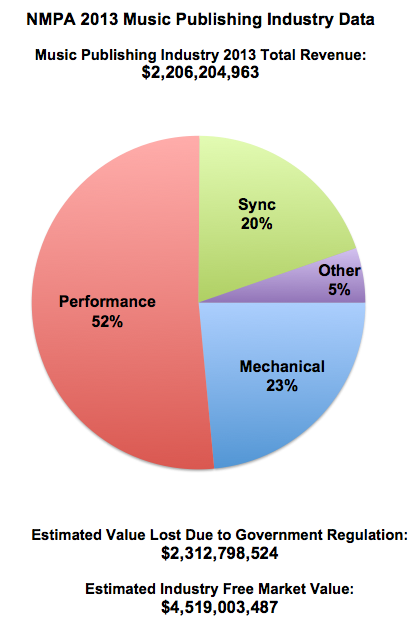
 The National Music Publishers’ Association (NMPA) today released 2013 revenue data for the U.S. music publishing industry. Revenue across all income sources totaled $2.2 billion, but the organization estimates even more, $2.3 billion, was lost due to outdated copyright law and government regulations.
The National Music Publishers’ Association (NMPA) today released 2013 revenue data for the U.S. music publishing industry. Revenue across all income sources totaled $2.2 billion, but the organization estimates even more, $2.3 billion, was lost due to outdated copyright law and government regulations.
“We are finally able to capture what the industry is worth and, more importantly, what our industry is losing,” said David Israelite, NMPA President and CEO today at the organization’s annual meeting in New York City, where the data was revealed. “The new digital marketplace is changing how songwriters and their music publishing partners can thrive. As the marketplace evolves, it is essential our industry no longer be hamstrung by outdated laws and government regulation.”
For the first time in history, NMPA can quantify the total industry revenue and value through information collected from NMPA’s recent modernization program. The program requires music publishing members to provide revenue data and captures market share information. The total industry revenue is based on numbers reported to NMPA by its members for 2013. The lost revenue calculations are based on projected fair market value of the industry in the absence of government regulations.
Where the money comes from:
(according to NMPA)
Performance License, 52 percent: Public performance royalties are the largest income stream for songwriters and music publishers. While the performance right is not explicitly regulated by law, the Department of Justice imposed consent decrees on the performance rights organizations ASCAP and BMI in 1941, which are still in effect today.
Mechanical License, 23 percent: Section 115 of the Copyright Act imposes a compulsory license that dates back to 1909. As a result of this law, songwriters and music publishers are denied the right to negotiate the value of their intellectual property in a free market. For every song downloaded on iTunes, songwriters receive only 9.1 cents – the current rate set by the Copyright Royalty Board.
Sync License, 20 percent: Traditionally this has included using music in movies, television shows, and commercials. Newer forms of this right include music videos produced by record labels as well as user-generated content such as videos on YouTube. For songwriters and music publishers, this is a free market right not regulated by law or consent decrees.
Other, 5 percent: Examples include sheet music and lyric websites.

Category: Featured, Organizations, Publishing
About the Author
Sarah Skates has worked in the music business for more than a decade and is a longtime contributor to MusicRow.View Author Profile


